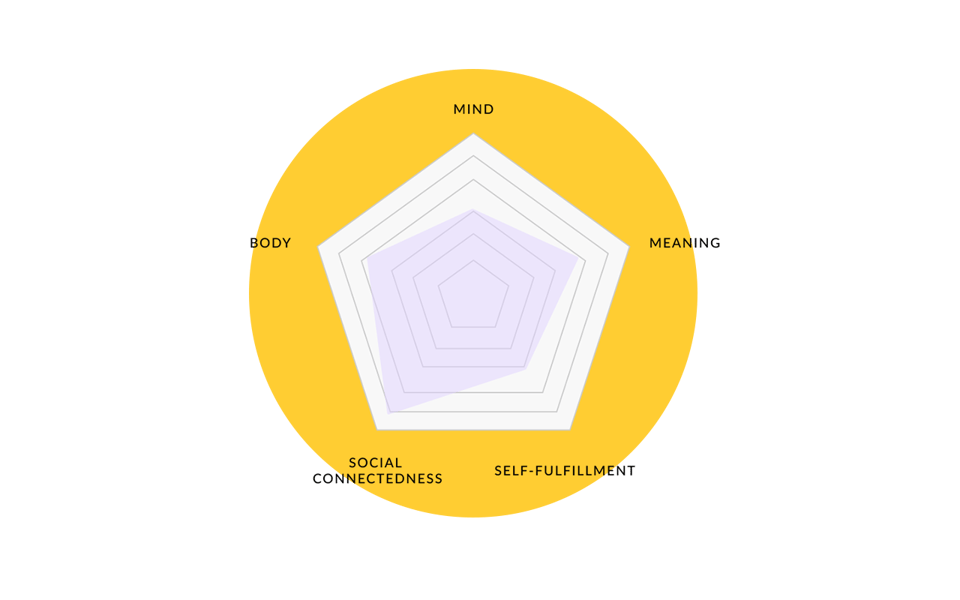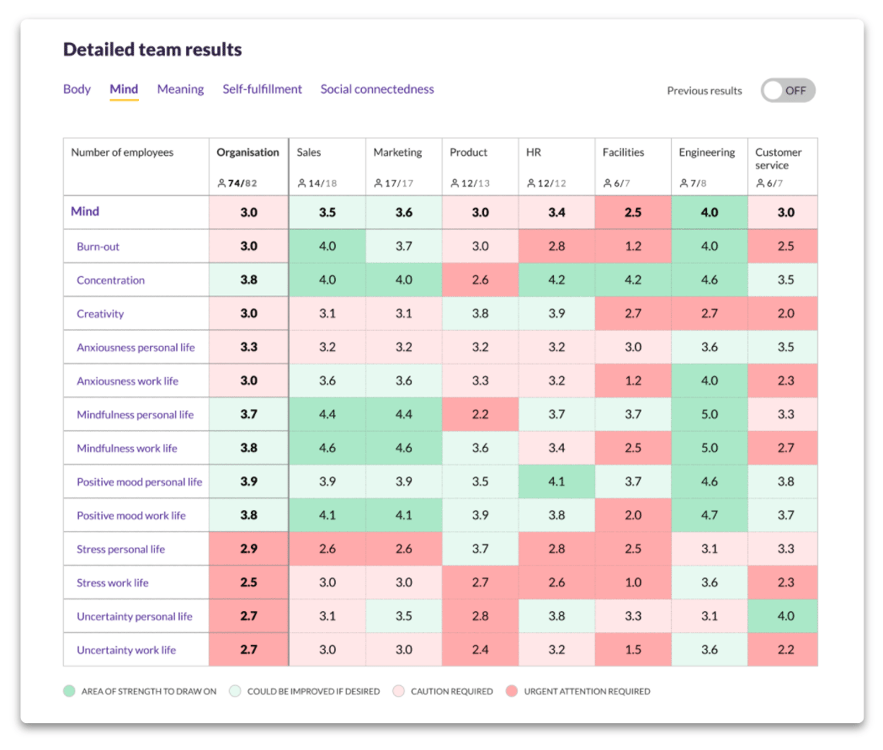A holistic approach to employee well-being is the only way to effectively improve it, and measuring it on three levels - individual, team and organizational - is the key to success.

Background photo by Nico Baum on Unsplash
Well-Being
/wel-bee-ing/
Noun [U]
The experience of mental and physical health and the sense of meaning, self-fulfilment and social-connectedness.
Social media channels like Linkedin and business news are replete with articles on how the pandemic has, and will continue to, change our relationship to work. Headlines predict the mass-exodus of disgruntled and burnt-out workers as we all try to find jobs and companies that see us as human beings and not just another cog in the proverbial corporate machine.
Some companies want to promote themselves as more attuned to the human toll the last year-and-a-half (and counting) has taken on us. Among other things, they have started adding more mental health and flexible working options into their repertoires, and those are commendable efforts to be sure, but it can be hard to know if there are real conversations and decisions happening at the top levels of management to uncover the underlying issues at play and make the changes needed to course-correct.
Then there is a whole slew of organizations attempting to help their employees by offering well-meaning, albeit generic solutions, “hosting online yoga sessions, sending employees smoothies and providing ergonomic office equipment.” And while I regularly practice yoga and love a green smoothie, these “perks” often only offer short-term relief to the most obvious, outward symptoms of our collective burn-out. This new slate of employee benefits fail to tackle the underlying issues that make us all crave some relief so desperately.
But more importantly, in order for any company - or individual for that matter - to effectively and positively impact well-being, we need to first understand the complexity of being human, step away from the internal and external struggles that come from overly-compartmentalizing ourselves, and embrace that effective employee well-being means acknowledging and supporting the whole person you employ.
The Hard Truth About Getting Business to Care
Of course it's dangerous to generalize - there are great examples of companies that have made employee well-being part of their DNA for decades already, but if we’re really honest with ourselves we also know that most companies, at the end of the day, are looking at their financial numbers. The ones that have espoused a more “balanced” approach to company culture have generally done so on the basis of a long-held belief that these sustainable practices are good for business.
“We believe in a world where individual well-being is prioritized as a key to business success, equal or greater to financial KPIs.”
Well-being is not simply a by-product of engagement survey results. It directly impacts how we work and employee mental, physical and emotional fitness to engage. At the end of the day, whether you choose to talk about it or not, well-being directly impacts productivity and performance.
With this in mind, at Quan we knew we needed to find a way to take a complex human-driven topic - well-being - and find a way to reliably quantify and track it over time. Our five-dimensional framework provides both individuals and organizations a way to translate employee well-being into a business KPI, and directly link it to revenue-generating and cost-creating business outcomes. Yes, our well-being framework means you can measure the ROI of your company’s efforts to improve and support employee well-being.
Building a Common Language: The 5 Dimensions of Well-Being
Founded on science, our multi-disciplinary team compiled conclusions from more than 150 scientific and academic papers, and spoke to more than 300 global experts (including doctors, psychologists and therapists, among others) to identify over 20 sub-dimensions of well-being underpinned by more than 250 “well-being predictors” so that our framework effectively captures and measures the complexity of well-being.
Simply broken down, Quan’s holistic view of well-being consists of five dimensions.

Dimension 1: Body
An individual’s perception of their physical condition.
Dimension 2: Mind
An individual’s perception of their thoughts and feelings.
Dimension 3: Meaning
An individual’s perception of their life having purpose, value and coherence.
Dimension 4: Self-Fulfilment
An individual’s perception of fulfilment of their potential and talents.
Dimension 5: Social-Connectedness
An individual’s perception of having close interpersonal relationships.
We recognised the need to improve people’s understanding of well-being with a clear framework for holistic well-being, and then provide them with the practical means to improve self-care.
Giving Well-Being a Place
When thinking about how to effectively improve employee well-being, further context to those dimensions is still needed - people don’t just check their personal lives at the door when they walk into the office (or connect remotely), nor does the impact of their working day dissipate into a cloud of soft mist when they close their laptop for the day.
When you ask employees about their well-being you need to understand to which context - personal or work life - the particular question relates. A requirement for any potential solution lies in understanding the root cause, not just dissecting the collateral damage. The shared language that the five well-being dimensions provide, with the additional context of personal life, work life and in some cases even the world as a whole, can lead us to think more creatively as employers and leaders on how we can actually help our people.
Once your people have taken themselves through the exercise of assessing their current state of well-being, you’re now in a position to begin to interpret what the results mean and what you (and they) can do about it. It’s time to come to the table with that newly shared language of well-being and begin to take action on the three levels that complete Quan’s holistic well-being framework.
Level 1: Individual
Employees complete a general assessment and can immediately see how they score on the five well-being dimensions.

They are then invited to take a deep-dive assessment into one of the sub-dimensions from their lowest-scoring dimension. This is what it means to quickly pinpoint the drivers behind a low area of well-being. The individual will immediately see which aspects of their well-being they would most benefit from taking action on with the support of those they already trust around them. No one is waiting for HR to come back with the results (and resulting plan) of the company engagement survey.
Level 2: Team
After team members take the assessments, they now have the first tool necessary towards supporting each others’ self-care efforts. Additionally, with anonymous aggregate team results direct managers have a powerful tool to lead discussions with their whole team around their well-being, and start (or continue) to build an open culture on the topic with their team, again, by tapping into that shared language they now all have.

Level 3: Organization
At the company level you now have dozens, if not hundreds, of employees and teams that have taken the assessment and you get an overall view of the holistic employee experience. Yes, you now know what kind of personal pressures your workforce is suffering from as well as what pressures are being exerted by your company. If you have a well-being strategy in place, the well-being overview gives you the data (again tapping into that shared language) to recalibrate where necessary. If you don’t - well now you have a baseline to understand where your priorities should be and how you can best support your people.

The Shared Responsibility of Employee Well-Being
The key to helping employees to meaningfully improve their well-being starts with building a clear and measurable framework in which individuals, teams and the whole organization can find a common language to come together and discuss the topic.
So many of us struggle with knowing how to talk about our own well-being to others and how to talk to others about theirs. We wanted to be able to show both individuals and leaders that if you can align the conversation around well-being at your organization (or at least within individual teams if your senior leadership isn't as convinced as you), then you can make a measurable impact on employee well-being while also effectively tracking ROI of your well-being investments.
It’s ridiculous to think that any employer can meaningfully support their employees’ well-being if they are limiting their understanding through the lens of employee engagement surveys and performance reviews. Low engagement and performance are symptoms of what ails your employees but they don’t give you any real insight on what to do next.
It’s equally ridiculous for us to expect an individual to improve their own well-being if their team and organization cannot align and support their efforts towards self-care. There is only one outcome to a story that I've personally experienced - the more friction and conflict I feel from my work life, the quicker I will try to find a new job. As an employer, if you want to hold onto your talent you need to reduce that friction as much as you can.
Companies need ways to quickly hone in on the deep-seeded drivers of well-being risks, and be brave enough to face the endemic problems that might be uncovered. That way, as leaders, we can take quick, decisive action the same way we would in the face of an alarming quarterly sales forecast.
However, the reality today remains, if businesses are going to prioritize people, in most cases it’s going to be because they can actually prove to their shareholders that it can directly and positively impact business KPIs. While not the most altruistic of ways to get there, maybe it’s not a bad thing if the result is that many more of us can benefit from a little more peace and a little more space to breathe.
Want to see how Quan's digital platform can help your organization better understand their well-being, takes steps to improve it while also measuring the ROI of your company's well-being programs?



Comments